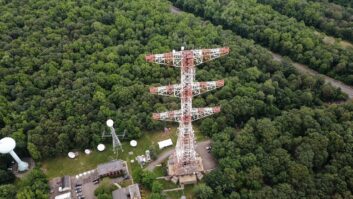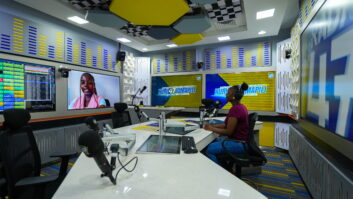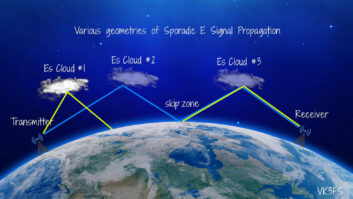The author chairs the NRSC RDS Usage Working Group.
FM translators have been a source of growth for the U.S. broadcast industry. Regulatory changes such as AM revitalization and the provisions allowing HD multicast translators have brought large interest in these FM signals. They brought new exposure to AM broadcasters struggling with an ever-increasing noise environment and a younger population less familiar with the eldest broadcasting band. AM stations and HD multicast stations that can obtain translators are not only breathing fresh air but offering additional, new content to larger audiences. Niche formats and communities are being served by these translators.
Listeners are already familiar with FM’s band, receivers and high-fidelity stereo audio. Translators allow new voices to “look” the same as traditional full-powered FM stations using RDS. Over the past few years, many translators have employed RDS encoders to offer relevant metadata to their audiences.

Fig. 1
UNEXPECTED USE
The use of RDS on translators is encouraged, especially in today’s modern automotive world, where so many vehicle infotainment systems display RDS text data when tuned to FM stations. In the digital dashboard, the translator stations can compete by providing a similar metadata experience including station names, song title and artist.
But this new use of RDS had not been envisioned by the original NRSC-4 FM RBDS standard.
The National Radio Systems Committee, jointly sponsored by the National Association of Broadcasters and the Consumer Technology Association, is a standards organization that publishes the NRSC-4 document. NRSC-4-B, updated in 2011, was refreshed just before the new use of FM translators was permitted. It and prior editions offer a formula for each full-powered FM station to use its call sign to calculate a unique four-character identifier called a Program Identifier or PI code; but FM translator call signs are not compatible with the formula, creating a dilemma for broadcasters enabling RDS on FM translators where programming originates from an AM or HD multicast station.
In 2012, the NRSC issued a guideline document, NRSC-G300, providing advice for the industry in this area. However this was published just as this influx of translators was beginning. NRSC-G300 essentially offered broadcasters guidance on how to arrive at what was hopefully a unique PI code for their broadcast area.
The guidance was helpful but merely a temporary workaround; a better method was needed. Few broadcasters had at their disposal the tools or knowledge to find a unique code in their area. Clearer guidance was necessary to take guesswork out of the process.
YOU’VE GOT A CODE
The NRSC has worked with NAB Pilot to devise a PI code assignment for each licensed FM translator in the United States. These codes are assigned automatically based on data in the FM database. The assignments are processed daily and include anything new published in the FCC FM Database.
The codes are unique for each specific translator’s geographic coverage area and adjacent areas. This is important to prevent inadvertent and unintended Alternate Frequency (AF) switching between other translators in the region.
In addition, the codes are calculated in a way so as to be frequency-unique, making them compatible with the RadioDNS standard, an open standard of locating metadata or streaming services of terrestrial broadcast stations. It allows this new class of stations to look towards the future and hybrid FM-plus-streaming radio designs.
While all of this sounds complicated — and the assignment process behind the scenes certainly is — a newly launched NRSC PI Code Allocation site takes the complication away.
It is available now at http://picodes.nrscstandards.org. Licensees of FM translators can look up their assigned codes by typing in their call sign, frequency, FCC Facility ID, city of license and state.
CHANGE LOG
To follow the example shown in Fig. 1, type the translator call sign of W286BK and select “Filter” and you will see that the PI code assigned for this translator is D3B7. This is the PI code you would enter in the RDS encoder for this translator.
To confirm you have the correct translator selected, there is a link with the Facility ID to bring you to the FCC database entry for this station. The city and state of license are listed, as are the coordinates in NAD 27 format, as shown on the station license. The PI code allocator also shows the last date the calculator processed an entry for this station.
Many of the translators that were on the air by June 1, 2017, will list that date. New translators added to the database, translators that have made significant site moves may trigger a change or any frequency change will trigger a new code.
This raises a good point: FM translators are often moved or upgraded, involving transmitter site locations and frequency changes. If you made a modification to your translator, check the calculator after the FCC has authorized the change; the station may have a new PI code assigned to it. This is by design. The calculator detected that the code previously assigned to this station is now in conflict with another station, so it assigned a new code to the station that changed.
The calculator keeps a change log at http://picodes.nrscstandards.org/audit.html and recent changes are available there as well for audit.
Alan Jurison is a senior operations engineer for iHeartMedia’s Engineering and Systems Integration Group. He chairs the NRSC RDS Usage Working Group. His opinions are not necessarily those of iHeartMedia, the NRSC or Radio World.







